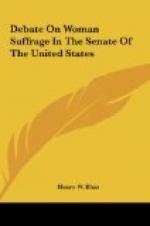But we are informed that woman does not vote when she has the opportunity. Wherever she has the unrestricted right she exercises it. The records of Wyoming and Washington demonstrate the fact.
And in these Territories, too, as well as wherever else she has exercised the suffrage, she has elevated man to her own level, and has made the voting precinct as respectable and decorous as the lecture-room or the assemblies of the devout. All the experience there is refutes the apprehension of those who fear that woman will either neglect the discharge of her great duty, when allowed its fair and equal exercise, or that the rude and baser sort will overwhelm and banish the noble and refined.
But to my mind it seems like trifling with a great subject to dwell upon topics like this. It can only be justified by the continual iteration of the objection by the opponents of woman suffrage, who in the lack of substantial grounds whereupon to base their opposition to the exercise of a great right by one-half the community declare that there is no time in which woman can vote.
I will now read an extract from the report of the majority of the committee, showing to a certain extent the degree of consequence which this movement has assumed, its extent throughout our country, and something of its duration. I have not the latest data, for since this report was compiled there has been action in several States, and a great deal of popular discussion and a vast amount of demonstration from the action of popular assemblies.
The committee say:
This movement for woman suffrage has developed during the last half century into one of great strength. The first petition was presented to the Legislature of New York in 1835. It was repeated in 1846, and since that time the petition has been urged upon nearly every Legislature in the Northern States. Five States have voted upon the question of amending their constitutions by striking out the word “male” from the suffrage clause—Kansas in 1867, Michigan in 1874, Colorado in 1877, Nebraska in 1882, and Oregon in 1884.
The ratio of the popular vote in each case was about one-third for the amendment and two-thirds against it. Three Territories have or have had full suffrage for women. In two, Wyoming since 1869 and Washington since 1883, the experiment (!) is an unqualified success. In Utah Miss Anthony keenly and justly observes that suffrage is as much of a success for the Mormon women as for the men.
In eleven States school suffrage for women exists. In Kansas, from her admission as a State. In Kentucky and Michigan fully as long a time. School suffrage for women also exists in Colorado, Minnesota, New Hampshire, Massachusetts, Vermont, New York, Nebraska, and Oregon.
In all these States, except Minnesota, school suffrage was extended to women by the respective Legislatures, and in Minnesota by the popular




